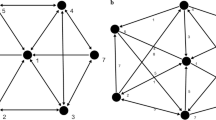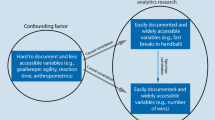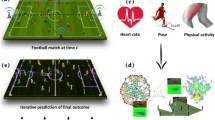Abstract
Performance analysis is a subdiscipline of sports sciences and one-approach, notational analysis, has been used to objectively audit and describe behaviours of performers during different subphases of play, providing additional information for practitioners to improve future sports performance. Recent criticisms of these methods have suggested the need for a sound theoretical rationale to explain performance behaviours, not just describe them. The aim of this article was to show how ecological dynamics provides a valid theoretical explanation of performance in team sports by explaining the formation of successful and unsuccessful patterns of play, based on symmetrybreaking processes emerging from functional interactions between players and the performance environment. We offer the view that ecological dynamics is an upgrade to more operational methods of performance analysis that merely document statistics of competitive performance. In support of our arguments, we refer to exemplar data on competitive performance in team sports that have revealed functional interpersonal interactions between attackers and defenders, based on variations in the spatial positioning of performers relative to each other in critical performance areas, such as the scoring zones. Implications of this perspective are also considered for practice task design and sport development programmes.



Similar content being viewed by others
Notes
The principle of ‘fixing’ dyadic systems is currently being researched in a programme of work on collective decision making at the Australian Institute of Sports from a team dynamics perspective.
References
McGarry T. Applied and theoretical perspectives of performance analysis in sport: scientific issues and challenges. Int J Perform Anal Sport 2009; 9: 128–40
Hughes M, Franks I. Notational analysis: a review of the literature. In: Hughes M, Franks I, editors. Notational analysis of sport. 2nd ed. London: Routledge, 2004; 59–106
Glazier P. Game, set and match? Substantive issues and future direction in performance analysis. Sports Med 2010; 40 (8): 625–34
Hughes M, Bartlett R. The use of performance indicators in performance analysis. J Sports Sci 2002; 20: 739–54
Lago C, Martin R. Determinants of possession of the ball in soccer. J Sports Sci 2007; 25 (9): 969–74
Hughes M, Franks I. Analysis of passing sequences, shots and goals in soccer. J Sports Sci 2005; 23 (5): 509–14
Reep C, Benjamin B. Skill and chance in association football. J R Stat Soc 1968; 131 (4): 581–5
Reep C, Pollard R, Benjamin B. Skill and chance in ball games. J R Stat Soc 1971; A (134): 623–9
Franks I, Goodman D, Miller G. Human factors in sport systems: an empirical investigation of events in team games. Proceedings of the Human Factors and Ergonomics Society 27th Annual Meeting; 1983 Oct 10-14. Hum Fac Soc 1983; 27 (5) 383–6
Franks I, Partridge D, Nagelkerke P. World Cup 90: a computer assisted technical analysis of team performance. Technical report for the Canadian Soccer Association. Vancouver (BC): University of British Columbia, 1990
Hughes M, Robertson K, Nicholson A. An analysis of the 1984 World Cup of Association Football. In: Reilly T, Lees A, Davids K, Murphy W, editors. Science and football. London: E & FN Spon, 1988: 363–7
Partridge D, Franks I. A detailed analysis of crossing opportunities from the 1986 World Cup (part I). Soccer J 1989 May-Jun: 47–50
Partridge D, Franks I. A detailed analysis of crossing opportunities from the 1986 World Cup (part II). Soccer J 1989 Jun-Jul: 45–8
Grehaigne J. Systemic approach and soccer. In: Hughes M, editor. Notation of sport III. Cardiff: Centre for Performance Analysis, UWIC, 1999; 1–8
Scholz JP, Schoner G, Latash ML. Identifying the control structure of multijoint coordination during pistol shooting. Exp Brain Res 2000 Dec; 135 (3): 382–404
Davids K, Araújo D. The concept of ‘Organismic Asymmetry’ in sport science. J Sci Med Sport 2010; 13 (6): 663–40
Araújo D, Davids K, Hristovski R. The ecological dynamics of decision making in sport. Psychol Sport Exerc 2006; 7: 653–76
Araújo D, Davids K, Bennett S, et al. Emergence of sport skills under constraints. In: Williams AM, Hodges NJ, editors. Skill acquisition in sport: research, theory and practice. London: Routledge, Taylor & Francis, 2004; 409–33
Davids K, Button C, Araújo D, et al. Movement models from sports provide representative task constraints for studying adaptive behavior in human movement systems. Adapt Behav 2006; 14 (1): 73–95
Davids K, Handford C, Williams M. The natural physical alternative to cognitive theories of motor behaviour: an invitation for interdisciplinary research in sports science? J Sports Sci 1994; 12 (6): 495–528
Handford C, Davids K, Bennett S, et al. Skill acquisition in sport: some applications of an evolving practice ecology. J Sports Sci 1997; 15: 621–40
Gréhaigne J, Bouthier D, David B. Dynamic-system analysis of opponent relationships in collective actions in soccer. J Sports Sci 1997; 15 (2): 137–49
Davids K, Glazier P, Araujo D, et al. Movement systems as dynamical systems: the functional role of variability and its implications for sports medicine. Sports Med 2003; 33 (4): 245–60
Hristovski R, Davids K, Araújo D, et al. How boxers decide to punch a target: emergent behavior in nonlinear dynamical movement systems [combat sports special issue]. J Sports Sci Med 2006; 60–73
Richardson M, Marsh K, Baron R. Judging and actualizing intrapersonal and interpersonal affordances. J Exp Psychol Human 2007; 33 (4): 845–59
Araújo D, Davids K. Ecological approaches to cognition and action in sport and exercise: ask not only what you do, but where you do it. Int J Sport Psychol 2009; 40 (1): 5–1
McGarry T, Anderson D, Wallace S, et al. Sport competition as a dynamical self-organizing system. J Sports Sci 2002; 20: 771–81
Davids K, Araújo D, Shuttleworth R. Applications of dynamical systems theory to football. In: Reilly T, Cabri J, Araújo D, editors. Science and football V. London: Routledge, 2005; 547–60
Passos P, Araujo D, Davids K, et al. Information-governing dynamics of attacker-defender interactions in youth rugby union. J Sports Sci 2008; 26 (13): 1421–9
Passos P, Araújo D, Davids K, et al. Interpersonal pattern dynamics and adaptive behavior in multiagent neurobiological systems: conceptual model and data. J Motor Behav 2009; 41 (5): 445–59
Duarte R, Araújo D, Gazimba V, et al. The ecological dynamics of 1v1 sub-phases in Association Football. Open Sports Sci J 2010; 3: 16–8
Bourbousson J, Seve C, McGarry T. Space-time coordination dynamics in basketball: part 1. Intra- and inter-couplings among player dyads. J Sports Sci 2010; 28 (3): 339–47
Palut Y, Zanone P. A dynamical analysis of tennis: concepts and data. J Sports Sci 2005; 23 (10): 1021–32
Vilar L, Araújo D, Davids K, et al. Constraints on competitive performance of attacker-defender dyads in team sports. J Sports Sci. In press
Vilar L, Araújo D, Davids K, et al. Interdependence between perceptual and motor sub-systems in pattern-forming dynamics in team sports [abstract]. In: Sayama H, Minai A, Braha D, et al., editors. Eighth International Conference on Complex Systems; 2011 Jun 26-Jul 1; Boston (MA): NECSI 2011; 1601
Peper C, Bootsma R, Mestre D, et al. Catching balls: how to get the hand to the right place at the right time. J Exp Psychol Human 1994; 20: 591–612
Davids K, Renshaw I, Glazier P. Movement models from sports reveal fundamental insights into coordination processes. Exerc Sport Sci Rev 2005; 33 (1): 36–42
Acknowledgements
Luís Vilar was supported by a financial grant from the Portuguese Foundation for Science and Technology (SFRH/BD/43251/2008). The authors would like to acknowledge the three anonymous reviewers for their insightful and valuable comments on earlier versions of the manuscript. The authors have no conflicts of interest to declare that are directly relevant to the content of this article. No funding was received by Duarte Araújo, Keith Davids and Chris Button to assist them in the preparation of this article.
Author information
Authors and Affiliations
Corresponding author
Rights and permissions
About this article
Cite this article
Vilar, L., Araújo, D., Davids, K. et al. The Role of Ecological Dynamics in Analysing Performance in Team Sports. Sports Med 42, 1–10 (2012). https://doi.org/10.2165/11596520-000000000-00000
Published:
Issue Date:
DOI: https://doi.org/10.2165/11596520-000000000-00000




